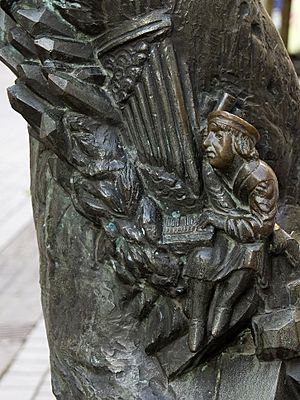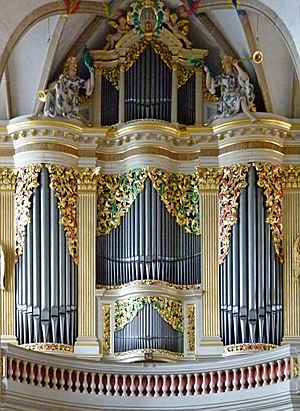Gottfried Silbermann facts for kids
Gottfried Silbermann (born January 14, 1683 – died August 4, 1753) was a famous German builder of musical instruments with keyboards. He made harpsichords, clavichords, organs, and fortepianos. Today, he is best known for his amazing organs and early pianos.
Contents
Life of Gottfried Silbermann
We don't know much about Silbermann's early life. He was born in a small town called Kleinbobritzsch. His father was a carpenter. In 1685, his family moved to Frauenstein. It's possible he learned carpentry there too.
In 1702, he moved to Straßburg. There, he learned how to build organs from his brother. He also learned about the French way of building organs.
Silbermann returned to Germany in 1710 as a master craftsman. A year later, he opened his own organ workshop in Freiberg. His second big project was the "Grand Organ" in the Freiberg Cathedral. He finished it in 1714.
In 1723, he received a special title from the King of Poland and Elector of Saxony. It meant he was an "Honorary Court and State Organ Builder." Silbermann died in Dresden in 1753. He was still working on the organ at the Hofkirche when he passed away.
Silbermann's Organs
The organs that Gottfried Silbermann and his brother Andreas Silbermann built had a very clear and special style. This was true for how they looked and how they sounded. Gottfried Silbermann always stuck to this unique style.
He was very good at making money from building organs. This made him quite wealthy. His smart business practices helped him become almost the only organ builder in his area. His students even had to promise not to work in Central Germany.
Not everyone liked Silbermann's strict style. For example, Johann Sebastian Bach, a famous composer, preferred a different way of tuning instruments. Silbermann used a tuning called meantone temperament, which was less flexible.
Silbermann designed and built about 50 organs. The Gottfried Silbermann Society says that 35 of these organs still exist today. This includes the organ in the Hofkirche in Dresden. The organs in the Hofkirche and Freiberg Cathedral are thought to be his best works.
The organ in Freiberg Cathedral has three manuals, which are like keyboards. It also has 41 stops. These stops control different sounds and are divided into sections called "divisions." Each manual usually plays one division. Silbermann's organs are known for their strong reed sounds and a wide variety of stops. Their pipes have a lot of tin, which gives them a bright, clear tone.
Silbermann and the Piano
Silbermann was also very important in the history of the piano. He helped pass on the important ideas of Bartolomeo Cristofori, who invented the piano. This made sure Cristofori's ideas didn't get lost. Silbermann also invented an early version of the damper pedal.
Records show that Silbermann built his first piano in 1732. This was just one year after Cristofori died. Silbermann probably learned about Cristofori's invention from an Italian article. This article was translated into German in 1725 by a poet named Johann Ulrich König, who knew Silbermann.
In his best pianos, Silbermann carefully copied the complex moving parts from Cristofori's last instruments. He also copied Cristofori's clever inverted wrest plank. For other parts, like the case and keyboard, Silbermann used his own experience as a harpsichord builder.
In the 1740s, King Frederick the Great of Prussia became interested in Silbermann's pianos. He bought several of them. Two of Silbermann's pianos are still in Frederick's palaces in Potsdam today. They look simple and elegant, even among the fancy decorations around them.
There is also an original Silbermann piano in the Germanisches Nationalmuseum. The famous musician Carl Philipp Emanuel Bach worked for Frederick the Great in Potsdam. He played Silbermann fortepianos. So, Silbermann's pianos are connected to CPE Bach's music, which was written for these types of instruments.
In recent years, a 1749 Silbermann instrument has been used as a model to make modern piano copies.
The Forerunner of the Damper Pedal
Silbermann invented a special device. It allowed the player to lift all the dampers off the piano strings. This made the strings vibrate freely when played. This is what the damper pedal does on modern pianos.
Silbermann's device was different from today's pedal. It was a hand stop, not a foot pedal. The player had to stop playing with their hands for a moment to use it. So, it was used to change the sound of whole sections of music, not for small, quick changes like a modern pedal. Also, Silbermann's device could lift the dampers in the high notes and low notes separately. This idea has recently been brought back in some special modern pianos.
There are a couple of reasons why Silbermann might have invented this device. First, as an organ builder, he liked giving players many different sound options. Organ builders sometimes added extra sets of strings to harpsichords for more sounds.
Second, Silbermann had built very large hammer dulcimers called pantaleons. He built them for a musician named Pantaleon Hebenstreit. The pantaleon, like other hammered dulcimers, had no dampers. This created a long, ringing sound. Silbermann later had problems with Hebenstreit and was stopped from building more pantaleons. Some people think that by adding the damper-lifting stop to the piano, Silbermann was trying to get around this rule.
Silbermann and Bach
An 18th-century musician named Johann Friedrich Agricola told a story about Silbermann, Johann Sebastian Bach, and pianos. Agricola said that after Silbermann finished two pianos, he showed them to Bach. Bach said the high notes sounded weak and the keys were hard to play, even though the overall sound was nice.
Silbermann was upset by this criticism. But he took it seriously and worked to make his pianos better. We don't know exactly how he improved them. Maybe he learned from Cristofori's best instruments. The improved Silbermann pianos met with Bach's "complete approval." A sales record from 1749 even shows that Bach helped Silbermann sell one of his pianos.
Bach also approved of Silbermann's organs. He was asked by both the church and Silbermann to play the first concert on Silbermann's new organ at the Frauenkirche Dresden on December 1, 1736.
Silbermann's Pupils
Silbermann's most important impact on the piano might have been through his students. His nephew and student, Johann Andreas Silbermann, taught Johann Andreas Stein. Stein improved the "Viennese action," which was used in pianos played by famous composers like Haydn, Mozart, and Beethoven.
Another group of Silbermann's students were called the "twelve apostles." These builders left Germany during and after the Seven Years' War (1756-1763). They moved to England, where there were new chances for instrument builders. The "twelve apostles" included Johannes Zumpe. He invented an affordable, small square piano that made the instrument very popular. They also included Americus Backers, who helped invent the "English action." This was a changed version of Cristofori's original piano action.
Silbermann's role was very important because he always insisted on high quality for the piano's action. Cristofori's action was complex and hard to build. Many builders, like Zumpe, used simpler but less effective actions. But thanks to Backers and others, the idea of a complex but good action survived. The English action was later improved by Sébastien Érard and Henri Herz. Their improvements led to the action used in all grand pianos today. As factories started making pianos, it became cheap enough to include the complex modern action even in less expensive pianos. This proved Silbermann's original decision was right.
Silbermann was so famous as a builder and teacher that for many years, people thought he invented the piano. It wasn't until the 1800s that the credit was given back to Cristofori.
See also
 In Spanish: Gottfried Silbermann para niños
In Spanish: Gottfried Silbermann para niños
- List of historical harpsichord makers



